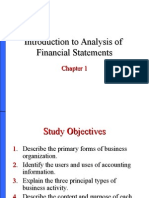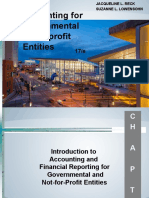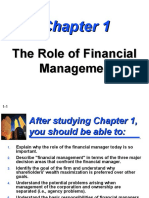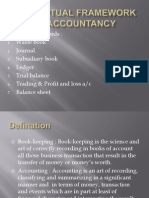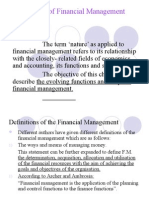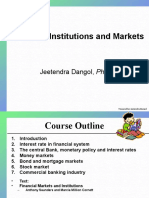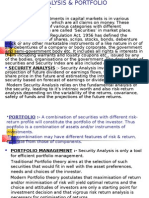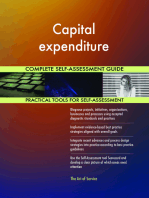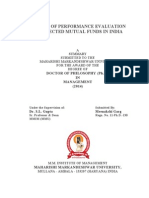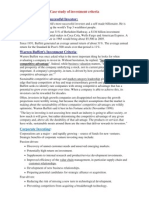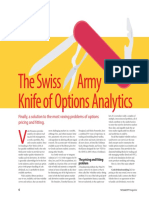Financial Management - PPT - Pgdm2010
Financial Management - PPT - Pgdm2010
Uploaded by
Prabhakar PatnaikCopyright:
Available Formats
Financial Management - PPT - Pgdm2010
Financial Management - PPT - Pgdm2010
Uploaded by
Prabhakar PatnaikOriginal Title
Copyright
Available Formats
Share this document
Did you find this document useful?
Is this content inappropriate?
Copyright:
Available Formats
Financial Management - PPT - Pgdm2010
Financial Management - PPT - Pgdm2010
Uploaded by
Prabhakar PatnaikCopyright:
Available Formats
Financial Management
K.V.RAMESH
Assistant ProIessor
Coordinator MBA ( PE )
Institute oI Public Enterprise
ay out
Nature oI Financial Management.
Investment & Financing Decisions.
Dividend Decisions.
iquidity Decisions or Working Capital
Management.
Financial management by Jonathan Berk / Peter DeMarzo & Ashok
Thampy.
Fundamentals oI Financial Management by James C.Van Horne and
John M. Wachowicz, Jr.
Fundamentals oI Financial management by Brigham & Houston
Financial management by I M Pandey
Financial management by G. Sudarsana Reddy
Contemporary Financial management by Raiesh Kothari and Bobby
dutta
Financial management by Shashi K. Gupta and R.K.Sharma
Financial management by Khan and Jain
Cost accounting and Financial management Khan and Jain
Fundamentals oI Financial management by Prasanna Chandra.
What is Finance ?
Finance stands Ior provision oI money as and
when required.
Process oI raising, providing and administering
all money/Iunds to be used in a corporate
enterprise.
Is concerned with the acquisition and
conservation oI capital Iunds in meeting the
Iinancial need and overall obiectives oI
business enterprise.
Approaches to Iinance
Providing oI Iunds needed by a business on
most suitable terms.
Cash.
Concerned with raising oI Iunds and their
eIIective utilisation.
Financial Management
The ways and means oI managing money.
Planning, acquisition, allocation, and utilisation
oI Iinancial resources with the aim to achieve
obiectives oI the Iirm.
Is the application oI planning and controlling
Iunctions to the Iinance Iunction.
Scope oI Finance Function
Estimating Iinancial requirements.
Capital structure decisions.
Selecting source oI Iinance.
Selecting pattern oI investment.
Proper Cash management.
Implementing Iinancial controls.
Proper use oI surpluses.
Aims oI Finance Iunction
Acquiring suIIicient Iunds.
Proper utilisation oI Iunds.
Increasing proIitability.
Maximising Iirm`s value.
Financial plan
Is a statement estimating the amount oI capital and determining its
composition.
Obiectives:
Availability oI adequate Iunds.
Balancing oI costs and risks.
Flexibility.
Simplicity.
ong term view.
iquidity.
Optimum use.
Economy.
Considerations
Nature oI Industry.
Credit rating oI the concern.
Future plans- Expansion and diversiIication.
Availability oI sources.
General economic conditions.
Government control.
Obiectives oI Financial management
ProIit:
ProIit earning.
ProIitability is a barometer Ior measuring eIIiciency and
economic prosperity oI a business.
Economic and business conditions do not remain the
same all the time.
ProIits are the main sources oI Iinance Ior the growth oI
the business.
ProIitability is essential Ior IulIilling social goals.
Wealth:
Maximizes the stockholders wealth.
ProIit Vs Wealth
The term proIit is vague.
Ignores the time value oI
money.
Ignores Risk Iactor.
Dividend policy.
Its an prescriptive idea.
Not necessarily socially
desirable.
Controversy obiectives
Maximize stockholders
wealth or wealth oI Iirm.
Ownership and management
are separated.
Functions oI a Finance manager
Financial Iorecasting and planning.
Acquisition oI Iunds.
Investment oI Iunds.
Helping in valuation decisions.
Maintain proper liquidity.
Functional areas oI FM
Determining Iinancial needs.
Selecting the source oI Iunds.
Financial analysis and Interpretation.
C-V-P analysis.
Capital budgeting.
Working capital management.
ProIit planning and control.
Dividend policy.
Organization oI Iinance Iunction
Board oI directors
Managing Director/ Chairman
Director (F)/ VP (F)/ CFO
Treasurer and Controller ( Financial
executives)
Responsibilities oI FE
The basic responsibility oI the treasurer is to
provide, manage and protect the Iirm`s capital.
The basic responsibility oI the controller is to
check that the Iunds are used eIIiciently.
Functions oI FE
Treasurer :
Obtaining Iinance
Banking relationship
Investor relationship
Short- term Iinancing
Cash management
Credit administration
Investments
Insurance
Functions oI FE
Controller:
Financial Accounting
Internal audit
Taxation
Management accounting and control
Budgeting, planning and control
Economic appraisal
Reporting to Government
FM Process
FM is a dynamic decision-making process
include a series oI interrelated activities
involving:
Financial planning
Financial decision-making
Financial analysis
Financial control
Concept of Time value of
money
Value of the money received today is more
than the value of the same amount of
money received after a certain period.
Reasons for Time value
Higher preference for present consumption
.
Purchasing power of the currency declines
with time.
Money received today can be invested to
earn suitable returns.
Reasons Ior Time PreIerence oI Money
The future is always uncertain and
involves risk.
People generally prefer spending than
deferring for future.
Money has time value because of
opportunities available to invest.
Timeline and Time travel
Timeline is a linear representation oI the timing oI the expected cash
Ilows. Timelines are an important Iirst step in organizing and then
solving a Iinancial problem.
A series oI cash Ilows lasting several periods as a stream oI cash
Ilows.
Rules oI Time travel
Only cash Ilows in the same units can be compared or combined at
the same point in time.
To move a cash Ilow Iorward in time, must compound it.
To move a cash Ilow backward in time, must use discounting.
Techniques oI Time Value oI Money
Compounding Technique
Interest is compounded when the amount earned on an initial deposit
becomes part oI the principal at the end oI the Iirst compounding period.
Principal reIers to the amount oI money on which interest is received.
n
Vn Vo(1)
Where Vn Future value at the period.
Vo Value oI money at time 0.
Interest rate.
Note: II calculations becomes diIIicult, the Iuture value oI money can be
calculated with the help oI Compound Iactor tables.
Vn Vo (CFi,n)
Where CFi,n is compound Iactor at percent and 3 periods.
Simple Interest vs Compound Interest
nterest paid/earned on original amount or on principal
borrowed is called the simple interest.
Symbolically P0((3
here P0 refers to deposit today i.e., t = 0
refers to interest rate per period
3 refers to number of time periods
Compound nterest is the interest paid/earned on any
previous interest earned as well as on the principal
borrowed.
n
Symbolically Po(1+ Po
Multiple Compounding Periods
In case the interest is payable on quarterly basis, compounding oI
interest twice a year say 30
th
June and 31
st
December every year.
The Iuture value oI money in the above said case/cases
mn
Vn Vo ( 1 /m)
Where Vn Future value oI money aIter 3 years.
Vo Value oI money at time 0
Interest rate
m Number oI times oI compounding per year
Multi Period Compounding
The actual rate oI interest realised called eIIective rate in case oI
multi period compounding is more than the apparent annual rate oI
interest called nominal rate.
EIIective rate oI interest is calculated with the Iollowing Iormula:
m
( 1 /m) 1
Where reIers to nominal rate oI interest
m reIers to Irequency oI compounding per year
Compounded value oI Annuity
nnuity is a series of equal payments lasting for some
specified period. hen cash flows occur at the end of
each period the annuity is called a Regular nnuity or
Deferred nnuity. f the cash flows occur at the
beginning of each period instead of at the end it is
called nnuity Due.
Future value of nnuity:
Vn = (R(CF3
Future value of nnuity Due:
Vn = (R(CF3(1 +
Problems
1. What will be the value oI Rs.100 aIter two years at 10 p.a. Rate oI interest iI
neither the principal sum oI Rs.100 nor interest is withdrawn at the end oI one
year.
2. From the above calculate the value oI Rs.100 ( 10 aIter ten years.
3. II you deposit Rs.1000 in an account earning 7 simple interest Ior two years.
What is the accumulated interest at the end oI the second year?
4. Calculate the compound value oI Rs.10,000 at the end oI third year ( 12
rate oI interest when interest is calculated on yearly and quarterly basis.
5. A company oIIers 12 rate oI interest on deposits. What is the eIIective rate
oI interest iI the compounding is done halI yearly, quarterly and monthly?
6. Mr. A deposits Rs.1000 at the end oI every year Ior Iour years and the deposit
earns a compound interest ( 10 p.a. Determine how much money he will
have at the end oI Iour years.
7. year Ior Iive years in a bank and the deposit earns a compound Mr. B deposits
Rs.5000 at the beginning oI each interest ( 8 p.a. Determine how much
money he will have at the end oI Iive years?
Discounting or Present Value Technique
Present value shows what the value is today of some future
sum of money. The Present Value Technique is known as
discounting because the present value of money to be
received in future will always be less.
V0 = Vn
1 +
here Vn is future value for 3 period
Vo is present value
Note: hen we use discount factors, the present value is
calculated by:
Present Value = Future Value x DF3
Present Value oI an Annuity
f the amount of payment is R, the present value of an
annuity can be calculated with the help of annuity discount
factor tables.
Vo = (R(DF3
Present value of an annuity due:
f the cash flows occur at the beginning of each year, the
present value of an annuity due is calculated by using
present value tables:
Vo = (R(DF3(1 +
Present value of an Infinite Life Annuity:
Vo = R/
Problems
1. Calculate the present value of Rs.1000 to be received after
one year @ 10% time preference rate.
2. Mr. X is to receive Rs.5000 after five years @ 10% p.a.
Calculate its present value.
3. Calculate present value of the following five years cash
flows assuming a discount rate of 10%. The cash flows for
each respective year are Rs.5000, Rs.10,000, Rs.10,000,
Rs.3000 and Rs.2000.
4. Mr. X has to receive Rs.2000 per year for five years.
Calculate the present value of annuity assuming that he
can earn interest on his investment @ 10% p.a.
5. Mr. has to receive Rs.10,000 at the beginning of each
year for five years. Calculate the present value of annuity
due assuming 10% rate of interest.
6. Calculate the present value of Rs.1000 received in
perpetuity for an infinite period taking discount rate of
10%.
Valuation oI Securities
onds with a maturity period:
n
Vd = _ Rt + Mn
(1+ Kdt (1+ Kdn
Vd = Value of bond
R1, R2 = nnual interest in period 1, 2 & so on.
Kd = Required rate of return
M = Maturity value of bond
n = Number of years to maturity
Note: f n becomes large we use present value tables, formula
is
Vd = (R(DF3 + (M(DF3
Bonds in Perpetuity/DDBs
onds which never mature or have infinite maturity period.
The value of such bonds is the discounted value of infinite
streams of interest (cash flows.
Vd = R
Kd
eep iscount Bonds: n
Vddb = FV / ( 1 + r r
Vddb = (FV x (DF3
here Vddb = Value of a deep discount bond
FV = Face value at maturity
r = Required rate of return
n = Number of years to mature / Life of DD
Problems
1. Mr.X is considering the purchase of a 8% Rs.1000 bond
redeemable after 5years at par, required rate of return is
10%. Calculate the amount to be paid for bond.
2. Xltd a company is proposing to issue a 5year debenture of
Rs.1000 redeemable in equal instalments@14% interest
p.a. f an investor has a minimum required rate of return
of 12%, calculate the debentures present value.
3. Mr. has a perpetual bond of the face value of Rs.1000.
He receives an interest of Rs.60 annually. hat would be
its value if the required rate of return is 10%.
4. Mr. has a perpetual bond of the face value of Rs.1000.
He receives an interest of Rs.60 annually. ts current value
is Rs.600. Calculate the yield to maturity.
5. D issued deep discount bond for a maturity period of 20
years and having face value of Rs.100000. Calculate the
value of DD if the required rate of return is 10%.
Valuation oI PreIerence share
1. Mr.A is considering the purchase oI a 7
preIerence share oI Rs.1000 redeemable aIter
5 years at par. What should be the pay now to
purchase the share assuming that the required
rate oI return is 8.
2. Mr.A has a irredeemable preIerence share oI
Rs.1000. He receives an annual dividend oI
Rs.80 annually. What will be its value iI the
required rate oI return is 10. ( d/kp)
Valuation oI Equity Share
Short term investor
Po = D1/1+ke + P1/ 1+ke
where Po refers to Current value of the share.
D1 Expected dividend
P1 Expected price of share
ke Required rate of return on equity
Mr.X is planning to buy an equity share for 1 year. The
expected dividend is Rs.7 and expected sale proceeds
Rs.200. Determine the value of the share assuming the
discount rate of 15%.
Note: f in the above case expected dividend and selling
price in the second year are Rs.7.50 and Rs.220. calculate
value of share.
D is constant
The value of share shall be calculated by using annuity
discount factor tables.
Po = (D (DF3 + (P3 (DF3
Mr.X expects a dividend of Rs.5 per share for each of ten
years and a selling price of Rs.80 at the end of ten
years. Calculate the present value of share if his
required rate of return is 12%.
Dividend Valuation Model
The concept of this model is that many investors do
not contemplate selling their share in the near future.
m t
Po = Z Dt / (1+ke
t=1
o growth: Po = D/Ke
Constant growth: Po = D1 = Do(1+g
Ke g Ke g
here Do is current dividend
D1 is expected dividend
Ke is required rate of return on equity
g is expected percent growth in dividend
Problems
1. company is expected to pay a dividend of Rs.6 per
share. The dividends are expected to grow
perpetually at a rate of 9%. hat is the value of its
share, if the required rate of return is 15%?
2. The current price of a companys share is Rs.200.
The company is expected to pay a dividend of Rs.5
per share with an annual growth rate of 10%. f an
investors required rate of return is 12%, should he
buy the share?
3. The current price of a companys share is Rs.75 and
dividend per share is Rs.5. Calculate the dividend
growth rate , if its capitalisation rate is 12%.
Rate oI Return on Equity Share
D1
Po =
Ke g
R
D1
Ke =
Po + g
The expected rate of return re, can be calculated with
the following formula:
D1 P1P0
re = +
Po P0
The market price of a share is Rs.80. The company is
expected to pay a dividend of Rs.4 and the share can
be sold at Rs.88. Calculate return on share. dvise
the investor to buy or not if his capitalisation rate is
10%.
hat is Cost of Capital?
s the minimum rate of return
expected by its investors.
s the rate of return that a firm
requires to earn from its projects.
s the minimum rate of return which
will at least maintain value of the
shares.
Definitions
A cut-oII rate Ior the allocation oI capital to
investment oI proiects. It is the rate oI return
on a proiect that will leave unchanged the
market price oI the stock.
Is the minimum required rate oI earnings or the
cut-oII rate oI capital expenditures.
The rate oI return the Iirm requires Irom
investment in order to increase the value oI the
Iirm in the market price.
Components of Cost of Capital
The expected normal rate of return at
zero risk level (ro.
Premium for business risk (b.
The premium for financial risk on
account of pattern of capital structure
(f.
Symbolically: K = ro + b + f
Form of Capital
Debt
Preference Capital
Retained Earnings
Equity Capital
Computation of Cost of Capital
Debt: Cost of debt is the rate of interest
payable on debt. Debt may be
irredeemable or redeemable.
Cost of debt beforetax: Kdb = /P
here ` is interest and `P is principal.
Cost of debt aftertax :
Kda = Kdb(1t = /NP (1t
here `NP refers to Net Proceeds
`t refers to rate of tax
Debt issued at a premium or
discount
Net proceeds received from the issue must be
considered and not the face value of securities.
Kdb = /NP
1.Compute cost of debt capital, rate of tax 50% where
X ltd issues Rs.50,000 8% debentures:
a at par.
b at premium of 10%.
c at discount of 5%.
2. L&T Ltd issues Rs.1,00,000 9% debentures at a
premium of 10%. The cost of floatation are 2%. The
rate of tax is 60%.Compute cost of debt.
Redeemable debt
efore Tax
+ 1/n(RVNP
Kdb =
(RV+NP
here ` is nnual nterest
`n is number of years in which debt is
to be redeemed.
`RV is Redeemable value of debt
`NP is Net proceeds of debentures.
3. company issues Rs.10,00,000
10% redeemable debentures at a
discount 5%. The cost of floatation
Rs.30,000.The debentures are
redeemable after 5 years. Calculate
before -tax assuming tax rate 50%.
Note: calculate aftertax cost of debt.
fter Tax
(1t+ 1/n(RVNP
Kdb =
(RV+NP
Cost of Preference Capital
t is a function of dividend expected by its investors.
Perpetual Kp = D/P
D refers to nnual Preference Dividend
P refers to proceeds
ssued at a discount or premium
Kp = D/NP
Redeemable
Kpr = D+MVNP/n
(MV+NP
MV refers to Maturity value of preference shares.
NP refers to Net Proceeds of preference shares.
Problems
Zee ltd issues 10,000 10% Preference shares of
Rs.100 each. Cost of issue is Rs.2 per share. Calculate
cost of preference capital if these are issued at par, at
a premium of 10% and at a discount of 5%.
Lakme ltd issues 10,000 10% preference shares of
Rs.100 each redeemable after 10 years at a premium
of 5%.The cost of issue is Rs.2 per share. Calculate
the cost of preference capital.
Ponds ndia ltd issues 1,000 7% preference shares of
Rs.100 each redeemable after 5years at par.
Calculate the cost of preference capital.
Cost of Retained Earnings
It is the rate oI return which the existing shareholders
can obtain by investing the aIter-tax dividends in
alternative opportunity oI equal qualities.
D1
Kr G
NP or MP
Where D1 is expected dividend at the end oI the year
G is Rate oI growth
To make adjustment in the cost of retained earnings for tax
and cost of purchasing new securities the following formula
is adopted.
Kr = (D/NP + G (1t(1b or
Kr = Ke(1t(1b
here Ke is rate of return available to shareholders.
`b is cost of purchasing new securities or brokerage costs.
firms return available to shareholders is 15%, the
average tax rate of shareholders is 40% and it is expected
that 2% is brokerage costs. hat is the cost of retained
earnings.
Cost of Equity
It reIers to the maximum rate oI return that the
company must earn on equity Iinance in order
to maintain the present market price oI the
stock.
Dividend yield method: Ke D/NP or MP
Dividend yield plus growth method:
Ke (D1/NP G) Do(1g)/NPG
Problems
1. company issues 1000 equity shares for Rs.100
each at a premium of 10%. company has been
paying 20% dividend for the past five years and
expects the same in near future. Compute the cost
of equity capital. ill it make any difference if the
market price of equity share is Rs.160?
2. company plans to wish you 1000 new shares of
Rs.100 each at par. The flotation costs are expected
to be 5% of the share price. The company pays
dividend of Rs.10 per share initially and growth in
dividends is expected to be 5%. Compute the cost
of new issue of equity shares.
f the current price of an equity share is Rs.150.
Calculate the cost of existing equity share capital.
Weighted average cost oI capital
Is the average cost oI the costs oI various sources oI
Iinancing.
It lies between the least and most expensive Iunds.
It enables the maximization oI proIits and the wealth oI
the equity shareholders by investing the Iunds in
proiects earning excess oI the overall cost oI capital.
Composite cost oI capital or Overall cost oI capital or
average cost oI capital.
Factors aIIecting WACC
Controllable Iactors.
Capital structure policy
Dividend policy
Investment policy
Uncontrollable Iactors
Tax rates
evel oI Interest rates
Market risk premium
Steps involved in computation WACC
Determination oI the source oI Iunds to be raised and
their individual share in the total capitalisation.
Computation oI cost oI speciIic source oI Iunds.
Assignment oI weight to speciIic source oI Iunds.
Multiply the cost oI each source by appropriate
assigned weights.
Add individual source weight cost to arrive cost oI
capital.
Assignment oI Weights
ook value
eights assigned on the basis of values found on the
balance sheet.
The book value of the source of fund divided by the book
value of total funds.
Merits:
1. Simple in calculation.
2. ook values provide a usable base, when firm is not listed
or security are not actively traded.
3. nalysis of capital structure i.e.,DE ratio
Demerits:
1. No relationship between book values and present
economic value of various sources of capital.
2. ook value proportions are not consistent with the concept
of cost of capital.
Assignment oI Weights
Market value:
eights assigned on the basis of market value of the
component of capital.
Market value of the component of capital divided by the market
value of all components of capital.
Merits:
1. Values are closely approximate the actual amount to be
received from their sale, representing the true value of the
investors.
2. Prevailing market prices are taken into account.
Demerits:
1. Very difficult to determine the market values because of
frequent fluctuations.
2. Equity capital gets greater importance.
3. f the market value of the share is higher than the book
value, CC would be overstated and viceversa.
Problems
1. Following is the longterm capitalization of a company:
40,000 Equity Shares of Rs.200 each with a market value of
Rs.160.
10% Preference Shares (10,000 of Rs.200 each with a
market value of Rs.240.
9% Debentures 2000 of Rs.2000 each with a market value of
Rs.2200.
Retained earnings Rs.20 Lacs.
dditional nformation:
flotation cost of 4% was incurred for cash instrument of
financing.
Redemption premium on debentures is 20%.
The current dividend of Rs.10 is expected to grow at 10% to
infinity. The term of maturity of debentures is ten years.
The company is taxed at 30%.
Preference dividend and nterest are payable annually.
Compute eighted average cost of capital using Market eights
and ook eights.
2. company has the following capital structure at the
end of March, 2010.
12% 2007 debentures Rs.15 Lacs.
9% Preference shares Rs.10 Lacs.
Equity Shares of Rs.10 each Rs. 12 Lacs.
The company has the marginal tax rate of 50%. t
is expected to pay a dividend of Rs.1.50 per
share this year and this dividend is expected to
grow at the annual rate of 10% in the future.
You are required to find out the firms cost of
capital from the above given information.
Marginal Cost oI Capital
Marginal Cost oI Capital is calculation oI the cost oI
additional Iunds to be raised.
Marginal Weights represent the proportion oI various
sources oI Iunds to be employed in raising additional
Iunds.
Demerits:
It ignores the long-term implications oI the new
Iinancing plans.
Fails in achieving the wealth maximization obiective in
the long run.
Capital Asset Pricing Model
This model was developed by William F.Sharpe.
This model explains as to what kind oI relationship
exists between risk and return namely
Relationship between Risk and Return Ior an
eIIicient portIolio.
Relationship between Risk and Return Ior an
individual security.
Importance CAPM
It provides a bench mark Ior evaluating various
investments.
It helps us to make an inIormed guess about the
return that can be expected Irom an asset that
has not yet been traded in the market.
Assumptions
nvestors have same information about securities.
Security returns are normally distributed.
There are no restrictions on investments.
nvestors can borrow and lend freely at a riskless rate
of interest.
The market is perfect i.e., no taxes, no transaction
costs, securities are completely divisible and market is
competitive.
nvestors have homogeneous expectations.
nvestors seek to maximize the expected utility of
their portfolios over a single period planning horizon.
Value oI Equity Share
It is a Iunction oI cash inIlows expected by the
investors and the risk associated with cash inIlows.
It is calculated by discounting the Iuture stream oI
dividends at the required rate oI return called the
Capitalization rate.
The required rate oI return depends upon the element
oI risk associated with investment in shares and is
equal to risk-Iree rate oI interest plus the premium Ior
risk.
CAPM
The premium Ior risk is the diIIerence between market
return Irom a diversiIied portIolio and the risk-Iree rate
oI return ie., beta co-eIIicient.
Ke RI (Rm RI)
Where Ke reIers to Cost oI equity capital
RI reIers to Risk-Iree rate oI return
Rm reIers to Market return oI a diversiIied
portIolio
reIers to Beta co-eIIicient oI the Iirm`s
portIolio.
Problems
1. You are given the Iollowing Iacts about a Iirm:
Risk-Iree rate oI return is 11.
Beta co-eIIicient oI the Iirm is 1.25.
Compute the cost oI equity capital using CAPM
assuming a market return oI 15 next year. What
would be the cost oI equity iI beta rises to 1.75.
2. The Capital td. wishes to calculate its cost oI equity
capital using CAPM. Company`s analyst Iound that
its risk-Iree rate oI return equals to 12, beta equals
1.7 and the return on market portIolio equals to
14.5.
nvestment Decisions
Capital budgeting is the process oI making
investment decisions in capital expenditures.
It is that expenditure incurred at one point oI
time whereas beneIits oI expenditure are
realised at diIIerent points oI time in Iuture.
It is concerned with the allocation oI the
Iirm`s scarce Iinancial resources among the
available market opportunities.
Distinction of capital budgeting
decisions
nvolves the exchange of current funds for
the benefits to be achieved in future.
Future benefits are expected to be realised
over a series of years.
Funds invested are in nonflexible and long
term activities.
nvolve huge funds and are irreversible
decisions.
re strategic investment decisions.
Nature of nvestment decisions
Large investments.
Longterm commitment of funds.
rreversible in nature.
Longterm effect on profitability.
Difficulties of nvestment decisions.
National importance.
Capital budgeting process
IdentiIication on Investment proposals.
Screening the proposals.
Evaluation oI various proposals.
Fixing priorities.
Final approval and preparation oI capital
expenditure budget.
Implementing proposal.
PerIormance review.
Techniques of Financial
Evaluation
Payback period.
Discounted payback.
ccounting rate of return.
Net present value.
nternal rate of return.
Profitability ndex.
PYCK PERD
This method throws light as to the length of the period by
which the entire investment would be recouped from
out of the future cash flows.
Cash flow means net profit after tax before depreciation.
dvantages:
Simple to understand and easy to calculate.
project with a shorter payback period is preferred
to the one having a longer payback period.
This method is suited to a firm which has shortage of
cash.
Disadvantages
t does not take into account the cash inflows earned
after the payback period and hence true profitability
of the projects cannot be correctly assessed.
gnores the time value of money.
t does not take into consideration the cost of capital.
t treats each asset individually in isolation with other
assets.
Cash outlay of the project
P =
nnual Cash inflows
Problems
1. There are two projects X and Y. Each project
requires an investment of Rs. 20,000. You are
required rank these projects according to P method.
The following are the net profit before depreciation
and after tax of the two projects for their respective
years. Project X Rs.1000, Rs.2000, Rs.4000, Rs.
5000 and Rs.8000. Project Y, Rs.2000, Rs.4000,
Rs.6000, Rs.8000.
2. Calculate discounted payback period from the
following information:
Cost of project Rs.6 Lacs, Life of project 5 years.
nnual Cash inflow Rs.2 Lacs, Cut off rate 10%.
ccounting Rate of Return
This method takes into account the earnings expected
from the investments over their whole life. Under this
method concept of profit is used rather than cash
inflows. The term profit refers to net profit after tax
and depreciation. The project with higher rate of
return is selected.
verage annual profit
RR =
Net investment in the project
Merits / Demerits
erits:
This method is fairly a simple calculation of averages.
This method takes calculations of average rate of
return for the entire life of the project by taking the
terminal salvage / scrap value.
emerits:
Does not take into account time value of money.
t does not take into account the quickness or the
rapidity with which the investment is recouped.
Problems
1. project requires an investment of Rs.5 Lacs and has a scrap
value of Rs.20,000 after five years. t is expected to yield profits
after depreciation and taxes during the five years amounting to
Rs.40,000, Rs.60,000, Rs.70,000, Rs.50,000 and Rs.20,000.
Calculate the average rate of return on the investment.
2. Calculate the average rate of return for projects and from the
following:
Project A
Project B
nvestments (Rs. 20,000 30,000
Expected Life (Years 4 5
Projected net income after tax and depreciation:
Years
1 2,000 3,000
2 1,500 3,000
3 1,500 2,000
4 1,000 1,000
5 1,000
f the required rate of return is 12%, which project should be undertaken?
Net Present Value
rupee in hand today is certainly more valuable than the
rupee which is received after a period of time. This method
attempts to calculate the return on investments by
introducing the factor of time element. The NPV method is
based on the fact that the cash flow arising at different
periods of time differ in value and are not comparable
unless there equivalent present values are formed.
erits:
t recognizes the time value of money
t takes into account the earnings over the entire life of the
project and true profitability of the investment proposal can
be evaluated.
t takes into consideration the objective of maximum
profitability.
emerits:
More difficult to understand and operate.
hile comparing projects with unequal
investment of funds, NPV may not give
good results.
t is not easy to determine the appropriate
discount rate.
Problems
1. No project is acceptable unless the yield is 10%. Cash
inflows of a certain project along with cash outflows are
give below:
Years utflows nflows
Rs. Rs.
0 1,50,000
1 30,000
20,000
2 30,000
3 60,000
4 80,000
5 30,000
The salvage value at the end of the fifth year is Rs.40,000.
Calculate NPV.
2. A company is considering investment in a proiect that
costs Rs.2 acs. The proiect has an expected liIe oI
Iive years and zero salvage value. The company uses
straight line method oI depreciation. The company`s
rate oI tax is 40. The estimated earnings beIore
depreciation and beIore tax Irom the proiect are
Rs.70,000, 80,000, 1,20,000, 90,000 and 60,000
respectively. You are required to calculate the net
present value at 10 and advise the company.
nternal Rate of Return
Time adiusted rate oI return or discounted cash Ilow or
discounted rate oI return or trial and error yield
method.
It is deIined as the rate oI discount at which the present
value oI cash inIlows is equal to the present value oI
cash out Ilows.
Accept the proposal iI the IRR is higher than or equal
to the minimum required rate oI return.
In case oI alternative proposals, select the proposal
with the highest rate oI return as long as the rates are
higher than the cutoII rate.
Steps
Determine the future net cash flows during the entire
economic life of the project.
Net cash inflows are estimated future profits before
depreciation but after taxes.
Determine rate of discount at which the PV of cash
inflows is equal to PV of cash outflows.
a hen annual cash flows are equal:
Calculate PV factor = initial outlay / annual cash
flow
Refer PV annuity tables and find out the rate at
which the calculated PV factor is equal to the
PV given in the table.
Steps
b hen annual cash flows are unequal
over the life of the asset.
Prepare the cash Ilow table using an arbitrary assumed
discount rate to discount the net cash Ilow to the PV.
Find out the NPV by deducing the PV oI total cash Ilows.
II NPV is positive, apply higher rate oI discount.
II higher discount rate still gives a positive NPV increase the
discount rate Iurther until NPV becomes negative.
II the NPV is negative at this higher rate, the IRR must be
between these two rates.
Merits / Demerits
erits:
t takes into account time value of money.
t considers the profitability of the projects over its
entire life.
t provides for uniform ranking of various proposals.
t is method which ensures reliable technique of
capital budgeting.
emerits:
t is difficult to understand.
t is difficult method of evaluation of investment
proposals.
This method assumes that the earnings are re
invested in the project, which is not justified.
Differences between NPV & RR
Size disparity
Time disparity
Projects with unequal lives
Reinvestment rate assumption
NPV method is a superior to that of
RR.
Profitability ndex R enefitCost Ratio
t is the relationship between present
value of cash inflows and outflows.
proposal is acceptable if the P is
greater than one
Problems
1. A company is considering an investment proposal to
purchase a machine costing Rs.2,50,000. The
machine has liIe expectancy oI Iive years and has no
salvage value. The company`s tax rate is 40. The
Iirm uses straight line method oI depreciation. The
estimated cash Ilows beIore tax aIter depreciation are
as Iollows: Rs.60,000, 70,000, 90,000, 1,00,000 and
1,50,000.
Calculate pay-back period, average rate oI return,
NPV and proIitability index at 10 discount rate.
2. company has investment opportunity costing Rs.40,000 with the following expected net
cash flow after taxes and before depreciation.
Year Net Cash flow (Rs.
1 7,000
2 7,000
3 7,000
4 7,000
5 7,000
6 8,000
7 10,000
8 15,000
9 10,000
10 4,000
Using 10% as the cost of capital, determine the following:
Payback period, NPV and P at 10% discount factor, RR with the help of 10% and
15% discount factor.
3. company can make either of two investments at the beginning of 2010. ssuming
required rate of return @ 10% per annum. Evaluate the investment proposals under
payback period, NPV, RR, P and discounted payback period.
The forecast particulars are given below:
Proposal Proposal
Cost of nvestment (Rs. 20,000 28,000
Life (Years 4 5
Scrap Value Nil Nil
Net ncome (after dep & tax Rs.
End of 2010 500 Nil
End of 2011 2,000 3,400
End of 2012 3,500 3,400
End of 2013 2,500 3,400
End of 2014 3,400
t is estimated that each of the alternative proposals will require additional
networking capital of Rs.2,000 which will be received back in full after the expiry of
each project life. Depreciation is provided under straight line method. The present
value of Re.1 to be received at the end of each year, at 10% and 14% may be
utilized.
You might also like
- Managerial Economics Chapter 3 PresentationDocument34 pagesManagerial Economics Chapter 3 Presentationtarekff100% (1)
- Introduction To Management AccountingDocument33 pagesIntroduction To Management Accountingsimranarora2007100% (1)
- Accounting Rate of ReturnDocument3 pagesAccounting Rate of ReturnDeep Debnath100% (1)
- Model Paper 1: Question No. 1Document11 pagesModel Paper 1: Question No. 1Ashish SinghNo ratings yet
- Budget AuthorizationDocument47 pagesBudget Authorizationshella.msemNo ratings yet
- Chapter 7. Leverage and Capital StructureDocument2 pagesChapter 7. Leverage and Capital StructureJhazz DoNo ratings yet
- IFRS Ethiopia D1S3 Presentation and Disclosure 3Document69 pagesIFRS Ethiopia D1S3 Presentation and Disclosure 3Yalem Alemayehu100% (1)
- 395 33 Powerpoint Slides 1 Financial Management Overview CHAPTER 1Document25 pages395 33 Powerpoint Slides 1 Financial Management Overview CHAPTER 1Ravi Pratap Singh TomarNo ratings yet
- MODULE 3 PPT Managerial Accounting As A CareerDocument27 pagesMODULE 3 PPT Managerial Accounting As A CareerAnnabel SenitaNo ratings yet
- Interest Rates and Their Role in FinanceDocument17 pagesInterest Rates and Their Role in FinanceClyden Jaile RamirezNo ratings yet
- Inflation AccountingDocument10 pagesInflation AccountingKunal ModiNo ratings yet
- Chapter 1 Analysis of Financial StatementsDocument55 pagesChapter 1 Analysis of Financial StatementsSonam Sanjay Dhameja100% (5)
- Accounting For Governmental & Nonprofit EntitiesDocument24 pagesAccounting For Governmental & Nonprofit EntitiesHibaaq AxmedNo ratings yet
- Chapter 13 Risk Analysis in Capital BudgetingDocument16 pagesChapter 13 Risk Analysis in Capital BudgetingAditya RaiNo ratings yet
- Ch. 15 - Capital Structure & LeverageDocument45 pagesCh. 15 - Capital Structure & LeverageLara FloresNo ratings yet
- Management AccountingDocument13 pagesManagement AccountingPravin TejasNo ratings yet
- Approaches To The Formulation of Accounting Theory PDFDocument31 pagesApproaches To The Formulation of Accounting Theory PDFwajeeda awadNo ratings yet
- Accounting For Public Sector and Civil Society 2022 LatestDocument170 pagesAccounting For Public Sector and Civil Society 2022 LatestZerai Hagos HailemariamNo ratings yet
- Cash Flow Statement-2015Document43 pagesCash Flow Statement-2015Sudipta Chatterjee100% (1)
- Basic Accounting Concepts: The Entity ConceptDocument56 pagesBasic Accounting Concepts: The Entity ConceptUttam Kr Patra100% (3)
- Introduction of Capital StructureDocument3 pagesIntroduction of Capital StructureshivavishnuNo ratings yet
- Support Department Cost AllocationDocument44 pagesSupport Department Cost AllocationAwan Wibowo100% (1)
- Accounting For LeasesDocument59 pagesAccounting For LeasesMei Chien Yap100% (2)
- FM 02-Financial Markets and Institutions The Process of Capital AllocationDocument3 pagesFM 02-Financial Markets and Institutions The Process of Capital AllocationJPIA Scholastica DLSPNo ratings yet
- Structure of AccountingDocument62 pagesStructure of AccountingSyafira AdeliaNo ratings yet
- Chapter 4 - Return and RiskDocument28 pagesChapter 4 - Return and RiskShahriar HaqueNo ratings yet
- FM - Bond & Stock ValuationDocument10 pagesFM - Bond & Stock ValuationSeneca GonzalesNo ratings yet
- Introduction To Investment Decision in Financial Management (Open Compatibility)Document5 pagesIntroduction To Investment Decision in Financial Management (Open Compatibility)karl markxNo ratings yet
- Lecture 1 - Introduction of Financial ManagementDocument18 pagesLecture 1 - Introduction of Financial ManagementMaazNo ratings yet
- Terminal Cash FlowDocument9 pagesTerminal Cash FlowKazzandraEngallaPaduaNo ratings yet
- Types of Financial Decisions in Financial ManagementDocument20 pagesTypes of Financial Decisions in Financial ManagementRahul Upadhayaya100% (1)
- Chapter Four: Insurance ContractsDocument14 pagesChapter Four: Insurance ContractstalilaNo ratings yet
- 3 - Unit I - Introduction To Financial Systems and Financial MarketDocument32 pages3 - Unit I - Introduction To Financial Systems and Financial MarketAmparo ReyesNo ratings yet
- Module 1 PPT Introduction To TaxDocument24 pagesModule 1 PPT Introduction To TaxAhmad Farhad Taneen100% (1)
- Cost and Management AccountingDocument51 pagesCost and Management Accountingabhijeet0% (1)
- Accounting For LeasingDocument36 pagesAccounting For LeasingAKSHAJ GOENKANo ratings yet
- A Report On THE STRUCTURE OF ACCOUNTING THEORYDocument19 pagesA Report On THE STRUCTURE OF ACCOUNTING THEORYMickeyMathewD'Costa100% (1)
- AccountDocument37 pagesAccountGaurang MakwanaNo ratings yet
- Accounting For Foreign Currency TransactionsDocument16 pagesAccounting For Foreign Currency TransactionsAaron AraulaNo ratings yet
- Introduction To Management AccountingDocument33 pagesIntroduction To Management AccountingSwapnil Singh ThakurNo ratings yet
- Overview of Financial ManagementDocument16 pagesOverview of Financial ManagementKAUSHIKNo ratings yet
- Working Capital: by Dr. M S KhanDocument13 pagesWorking Capital: by Dr. M S KhanMohd. Shadab khanNo ratings yet
- Financial Forecasting Planning 1226943025978198 9Document20 pagesFinancial Forecasting Planning 1226943025978198 9Surya PratapNo ratings yet
- Investement Analysis and Portfolio Management Chapter 5Document15 pagesInvestement Analysis and Portfolio Management Chapter 5Oumer ShaffiNo ratings yet
- Financial Management Nature and Scope.Document36 pagesFinancial Management Nature and Scope.Kane91% (11)
- Financial Institutions and MarketsDocument20 pagesFinancial Institutions and MarketsCome-all NathNo ratings yet
- Security Analysis & Portfolio ManagementDocument20 pagesSecurity Analysis & Portfolio ManagementKaneNo ratings yet
- Cangque A Bapf 103 Ba Module 1 For CheckingDocument27 pagesCangque A Bapf 103 Ba Module 1 For CheckingArmalyn Cangque100% (1)
- PPT-10 - Ethics in Consumer Protection and Community RelationsDocument31 pagesPPT-10 - Ethics in Consumer Protection and Community RelationsMuhammad Ali AdnanNo ratings yet
- LeasesDocument57 pagesLeasesnati50% (2)
- CVP Analysis - PPT (Autosaved)Document33 pagesCVP Analysis - PPT (Autosaved)Anonymous gDxeGLYNo ratings yet
- Lecture Notes Valuation of BondsDocument6 pagesLecture Notes Valuation of BondsBlueBlade100% (1)
- Advanced Financial Management Course OutlineDocument3 pagesAdvanced Financial Management Course OutlineMan TK100% (2)
- Financial Management - PPT - 2011Document134 pagesFinancial Management - PPT - 2011Bhanu Prakash100% (1)
- Financial Management - PPT - 2011Document183 pagesFinancial Management - PPT - 2011ashpika100% (1)
- Financial Management-2014Document114 pagesFinancial Management-2014kirankumarkakumaniNo ratings yet
- Time Value of MoneyDocument7 pagesTime Value of MoneyMary Ann MarianoNo ratings yet
- DHA-BHI-404 - Unit4 - Time Value of MoneyDocument17 pagesDHA-BHI-404 - Unit4 - Time Value of MoneyFë LïçïäNo ratings yet
- BB0011 Managing Financial Resources Set2Document24 pagesBB0011 Managing Financial Resources Set2prajnaprasadNo ratings yet
- StydyDocument7 pagesStydyZOEZEL ANNLEIH LAYONGNo ratings yet
- FM Unit 4 Lecture Notes - Time Value of MoneyDocument4 pagesFM Unit 4 Lecture Notes - Time Value of MoneyDebbie DebzNo ratings yet
- Ratio Analysis of Pepsi Co.Document88 pagesRatio Analysis of Pepsi Co.ZAS100% (2)
- BSP c1041Document2 pagesBSP c1041Maya Julieta Catacutan-EstabilloNo ratings yet
- Ben Graham Would Be Proud Self-EvidentDocument3 pagesBen Graham Would Be Proud Self-EvidentBaikaniNo ratings yet
- Other Comprehensive Basis of Accounting (OCBOA) Cash Basis Notes To The Financial StatementsDocument39 pagesOther Comprehensive Basis of Accounting (OCBOA) Cash Basis Notes To The Financial StatementsDexter P. VargasNo ratings yet
- What Is Financial CommunicationDocument11 pagesWhat Is Financial CommunicationRamlahBegumUmerkuttyNo ratings yet
- Donald Bradley Siderograph Model - Guide To 2014 Turn DatesDocument4 pagesDonald Bradley Siderograph Model - Guide To 2014 Turn DatesBradleySiderographNo ratings yet
- Coloured Diamonds As An InvestmentDocument15 pagesColoured Diamonds As An InvestmentHanwoodHoldings100% (1)
- Question For Manager Test in Ksfe PDFDocument11 pagesQuestion For Manager Test in Ksfe PDFRajimol RNo ratings yet
- Advanced Accounting TopicsDocument2 pagesAdvanced Accounting TopicsMudassir HaiderNo ratings yet
- A Study On Performance of Mutual FundDocument25 pagesA Study On Performance of Mutual Fundanushakc1991No ratings yet
- SAMPLE ONLY Topic - Real Estate Brokerage PracticeDocument3 pagesSAMPLE ONLY Topic - Real Estate Brokerage PracticeJoshua ArmestoNo ratings yet
- Case Study of Investment CriteriaDocument2 pagesCase Study of Investment CriteriammediboyinaNo ratings yet
- PG - M.B.a Financial Management - English - 357 44 Investment and Derivatives Market - 2652Document238 pagesPG - M.B.a Financial Management - English - 357 44 Investment and Derivatives Market - 2652Yash AgarwalNo ratings yet
- 09 StablecoinsDocument56 pages09 Stablecoinsayush agarwalNo ratings yet
- JP Morgan - Audacity of BitcoinDocument8 pagesJP Morgan - Audacity of Bitcoinarthurnitsopoulos_14No ratings yet
- PICPADocument9 pagesPICPACassNo ratings yet
- Summary Chap 12, MKL, Findi Kumala DewiDocument5 pagesSummary Chap 12, MKL, Findi Kumala Dewiresty auliaNo ratings yet
- Paul MerchantDocument12 pagesPaul MerchantShivani NarayanNo ratings yet
- AdelphiaDocument1 pageAdelphiaFlavien HarelNo ratings yet
- Lecture Notes Stochastic CalculusDocument365 pagesLecture Notes Stochastic Calculusdaselknam100% (2)
- RRRDocument288 pagesRRRwandisusNo ratings yet
- Couts Partiels Exercices CorrigésDocument12 pagesCouts Partiels Exercices CorrigésAbderrahmaneLamriNo ratings yet
- New PPT For Euro Issue 1Document28 pagesNew PPT For Euro Issue 1Bravoboy Johny83% (6)
- Annual Report 2016Document179 pagesAnnual Report 2016Tuong MinhNo ratings yet
- Maths Grade 11Document227 pagesMaths Grade 11Robert BrownNo ratings yet
- Fin Man 1 FINANCIAL Ratio AnalysisDocument15 pagesFin Man 1 FINANCIAL Ratio AnalysisAnnie EinnaNo ratings yet
- The Swiss Army Knife of Options Analytics: Vola DynamicsDocument4 pagesThe Swiss Army Knife of Options Analytics: Vola DynamicsdanNo ratings yet











